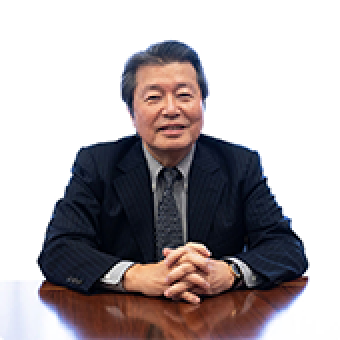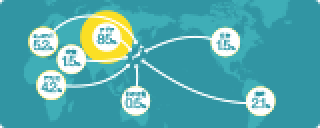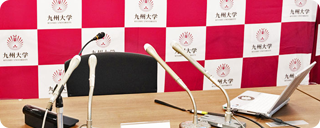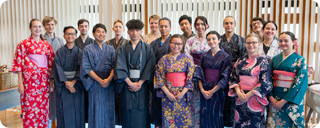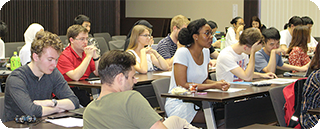トピックス Topics
Academic leaders gather in Fukuoka for QS-APPLE 2019
2019.12.24Topics
Over 700 people from nearly 40 countries gathered in Fukuoka from November 26 through 28 for QS-APPLE 2019 to share and develop ideas on dealing with a changing society and to build strategic connections across oceans—and right at the center of it all was Kyushu University as organizing partner.
For the 15th edition of this premier conference for higher education in the Asia Pacific run by Quacquarelli Symonds, the theme was “Industrial Revolution 4.0 and Ageing Societies: The Changing Roles of Universities in the Asia-Pacific,” a fitting topic for the event’s first trip to Japan.
The two-and-a-half days of QS-APPLE, which is short for Quacquarelli Symonds Asia-Pacific Professional Leaders in Education, were filled with keynote talks, panels, debates, and presentations covering best practices, initiatives, and challenges in higher education over a total of nearly 80 sessions.

Distinguished Professor Shunsuke Managi gives a keynote talk.
The conference’s plenary sessions featured several representatives from Kyushu University, from debates and keynote talks to opening and closing remarks.
On the first day, Prof. Megumi Takata of the Faculty of Economics and Natsuko Kitagawa, senior student of the School of Agriculture, joined two university representatives from Malaysia on stage to debate the relevance of universities in an ageing society post Industrial Revolution 4.0 at the QS Squared Debate.
Keynote talks included Distinguished Professor Shunsuke Managi of Faculty of Engineering discussing sustainability in an ageing society within the context of his work on resource and environmental economics and policy and a closing keynote talk from Dr. Koichi Wakata, Kyushu University graduate and current JAXA Vice President, on the final day.
Other highlights of the plenary sessions included a panel discussion on the difference between university and employer expectations for future graduates at the QS Dialogue and the QS Ranking Workshop, which featured discussion of the QS Asia Rankings University Rankings 2020 released the previous day.

Professor Takata (second from left) and fourth-year student Kitagawa (right) talk on stage during the QS Squared Debate.
A platform for sharing
While the plenary sessions allowed for conference-wide discussion of select topics, an integral part of the event was the breakout sessions, which consisted of five concurrent tracks of smaller, focused talks and gave a platform for a larger number of universities from around the world to share their developments.

Senior Vice President Ogata moderates a panel titled “Challenges of Building a University Brand in Developing Countries.”
The underlying themes of this year’s tracks were student body and faculty internationalization, promotion of research impact and graduates’ global employability, and development of global university brands.
Among the slate of speakers, several members of Kyushu University used this opportunity to present the universities latest programs and strategies.
Talks from Kyushu University included Professor Edward Vickers of the Faculty of Human-Environment Studies discussing the integration of international staff, Professor Aya Hagishima of the Faculty of Engineering Sciences detailing some of her experiences with double degree programs, and Senior Vice President Kazunari Sasaki sharing the university’s research efforts to realize a low-carbon society.
In addition, Senior Vice President Kazuo Ogata moderated a panel on the challenges of building university brands in developing countries.

Professor Hagishima

Senior Vice President Sasaki

Professor Vickers
Spotlight on Kyushu and Japan
Both inside and outside of the meeting doors, the conference was a unique opportunity for Kyushu University, Fukuoka, and Japan to make an indelible impression on visitors from around the world.
Welcome remarks to the entire conference included those from President Chiharu Kubo and Executive Vice President Makoto Aratono of Kyushu University and representatives from the Ministry of Education, Culture, Sports, Science and Technology and the prefecture and city of Fukuoka.

Executive Vice President Aratono receives the bronze award for Best International Website Page, which went to Kyushu University.
At the Welcome Dinner, held at Hotel New Otani on the first night of the conference, participants were wowed with Japanese drum and stringed-instrument performances.
As part of the Creative Awards presented during the dinner, Kyushu University took home bronze for Best International Website Page.
Japanese universities were also on display at the conference’s exhibition, which featured booths from over 80 education-related organizations.
Visitors entering the exhibition were greeted by the Study in Japan booth, which included 14 universities and related organizations participating in the Top Global University Project, with Kyushu University front and center.

Visitors and Kyushu University representatives discuss at the Study in Japan booth.
In addition to the Top Global University Project panel across from the reception desk for the conference, the booth provided a unique chance to highlight and connect with universities across Japan.
The final impression of the event was made by Kyushu University for the nearly 130 people who joined tours of campus in the afternoon of the conference’s final day.
Split across four courses featuring tours of the hydrogen station, the Center for Organic Photonics and Electronics Research, the Central Library, and the Exhibition and Observation Room of Ishigahara Tumulus, the tours gave the visitors a chance to experience the new Ito Campus firsthand.
Participants were treated to a sunset over Futamigaura on the bus ride back to their hotels, a fitting way to end the busy three-day conference and one final memory to take home of not only the new connections and information from the conference but also Kyushu University and Fukuoka.

President Kubo delivers the closing remarks.

Kyushu University’s section of the Study in Japan booth at the conference’s exhibition.

Drummers perform at the Welcome Dinner.

Participants register on the first day.

Executive Vice President Aratono gives welcome remarks.

Dinner is served at the Welcome Dinner.

A panel discusses “What do employers want from tomorrow’s universities graduates? What do universities think tomorrow’s employees need?” at the QS Dialogue on the second day of the conference.


